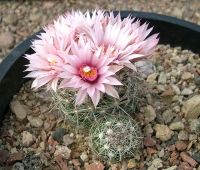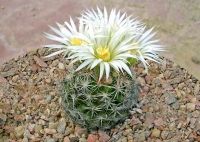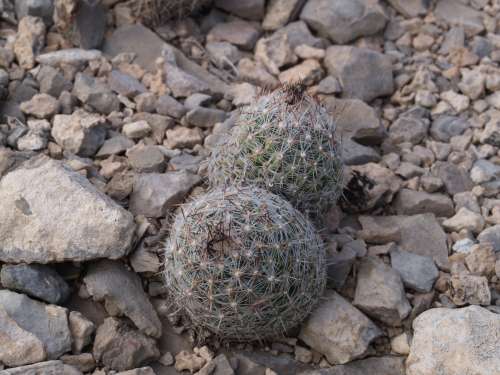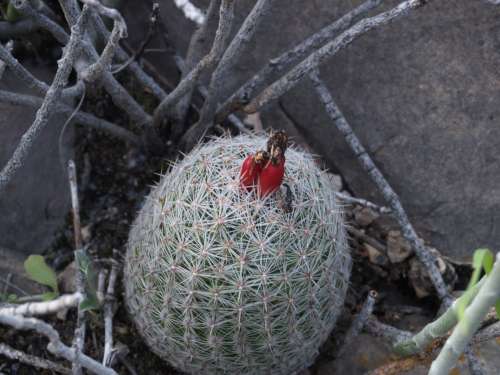Discussions - Mysterious and Unknown Escobarias
Unknown names, catalogue names, nomen nudum, nomen prov. etc.
Unknown names, catalogue names, nomen nudum, nomen prov., not described taxa:
If you recognize any taxon or if you know further information about the names listed below, please, send me an e-mail to the following address escobaria@atlas.cz .
 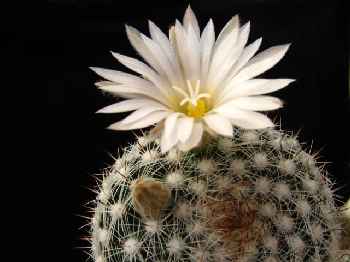 |
Escobaria spec. El Alicante (= vivipara ?) | |||
|
Do not you know what kind of vivipara this could be? Foto - Zdenek Vaško | ||||
Notes: | ||||
|
Zdenek Vaško (14.09.2008) - e-mail: zdenek.vasko@atlas.cz Do not you know what kind of vivipara this could be? I was quite surprised by its flower. Unfortunately, only one plant flowered this year and thus I do not know whether the colour of its flower would be the same also with the other plants. I was sort of surprised especially by the region in which the plant is attested. It is a border area of the Mexican states of Coahuila and Chihuahua close to El Alicante. As far as fruits and seeds are concerned, unfortunately I do not remember how did they look like. Translation by Jana Mynářová | ||||
|
Vladislav Šedivý (14.09.2008) - e-mail: vladsedivy@centrum.cz Could it be Escobaria vivipara var. kaibabensis? Nevertheless, I have never seen such a flower. Translation by Jana Mynářová | ||||
|
Jan Mynář (01.02.2009) - e-mail: escobaria@atlas.cz I have been looking at habitation of the individual varieties of Escobaria vivipara a little bit, trying to compare it with the plant on the photograph. Unfortunately I have to say that I failed in it. Next to the flower itself I am slightly surprised by its position which is, for escobarias of this complex, too far from the top of the plant. The flower remind me of a flower of Esc. tuberculosa a little bit, but as I have just browsed, its stem and spines, I also think that the plant might belong into the complex of Escobaria vivipara. I have also made some research in the literature and hereby I enlist some remarks from Zimmerman (1985). In Texas, from the other side of the region Chihuahua/Coahuila, var. neomexicana appears. The habitat is stated in Texas (USA) but also in the Mexican states of Chihuahua and Coahuila. However, in Coahuila I was able to find out only a site close to Cuatrocienegas, where it should appear on gypsum rocks. There is, however, a problem that the site is located relatively too far to south from the mentioned site at El Alicante. Also when comparing the spines, there are distinct differences visible. And I am not mentioning the flower. Another variety growing in Texas is radiosa. In this case, however, both the flower and the spines are completely different. I have also checked var. kaibabensis and the area of its habitation. Neither this one does seem to me to be similar to the one on the photograph. And in addition, the enlisted sites are too far - in Arizona (USA). Thus I am afraid that we will have to search further and to wait if the plants or the seeds will tell us more. It may also happen that the other plants will flower normally and it will be only an anomaly with this plant or that it will be a hybrid. Translation by Jana Mynářová | ||||
|
Vladimír Bureš (02.02.2009) - e-mail: bures.kakt@seznam.cz For comparison I'm hereby sending two photos of the vivipara-flowers from Botanical Garden in Zurich (Switzerland).
Translation by Jana Mynářová | ||||
|
Jaroslav Šnicer (02.02.2009) - e-mail: cult.tricka@seznam.cz According to my opinion, this plant can be identified as an Escobaria varicolor. It has got two forms and I would consider it as the old "gigantea". For sure, it is not a vivipara. Translation by Jana Mynářová | ||||
|
Hans Havel (02.02.2009) - e-mail: hahavel@aon.at I think that this plant can be identified as Escobaria tuberculosa. Lateral flowers are, for example due to a shock caused by a translocation of the plant, this year atypical and next year the plant will flower normally from the top. Hopefully, we will see the next flowers. I do not think that it is a vivipara. For example, in the area of Big Bend, we do not have any viviparas, the nearest location can be found 300 km to the north, close to Fort Davies, TX. Purported occurence of taxon vivipara at Cuatro Cienegas would be 200 km to the south-east, but before I start to believe in the existence of this plant, I would like to see here the flower. Translation by Jana Mynářová | ||||
|
Jan Mynar (10.01.2013) - e-mail: escobaria@atlas.cz Z. Vasko sent photographs from the site. Based on these photographs, I do believe that this is an Escobaria tuberculosa, namely subsp. varicolor. Stigma has a whitish colour, a fruit is red, seeds are supposedly brown, that means that the plant belongs to the Escobaria section. The stem is ovoid, not caespitose, the flower is big and whitish, that means a subsp. varicolor. I also agree with Mr. Havel, that the lateral flowers may be just an anomaly which shall not be manifested in the following years.
| ||||
Contributions to individual taxa send please to the following e-mail address escobaria@atlas.cz .
A form to create a new discussion page - new discussion .

© 2002-2013 Jan Mynar
Last modified January 10, 2013
[ Discussions - Mysterious and Unknown Escobarias ] [ Discussions ] [ HOME ]
